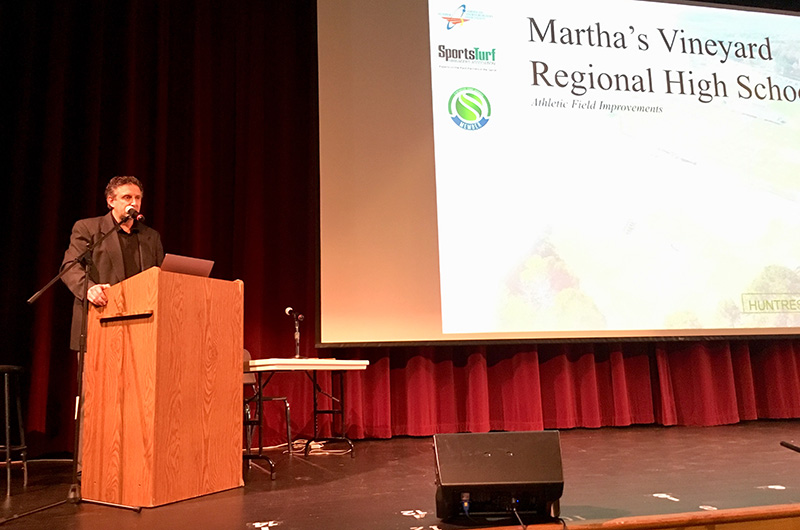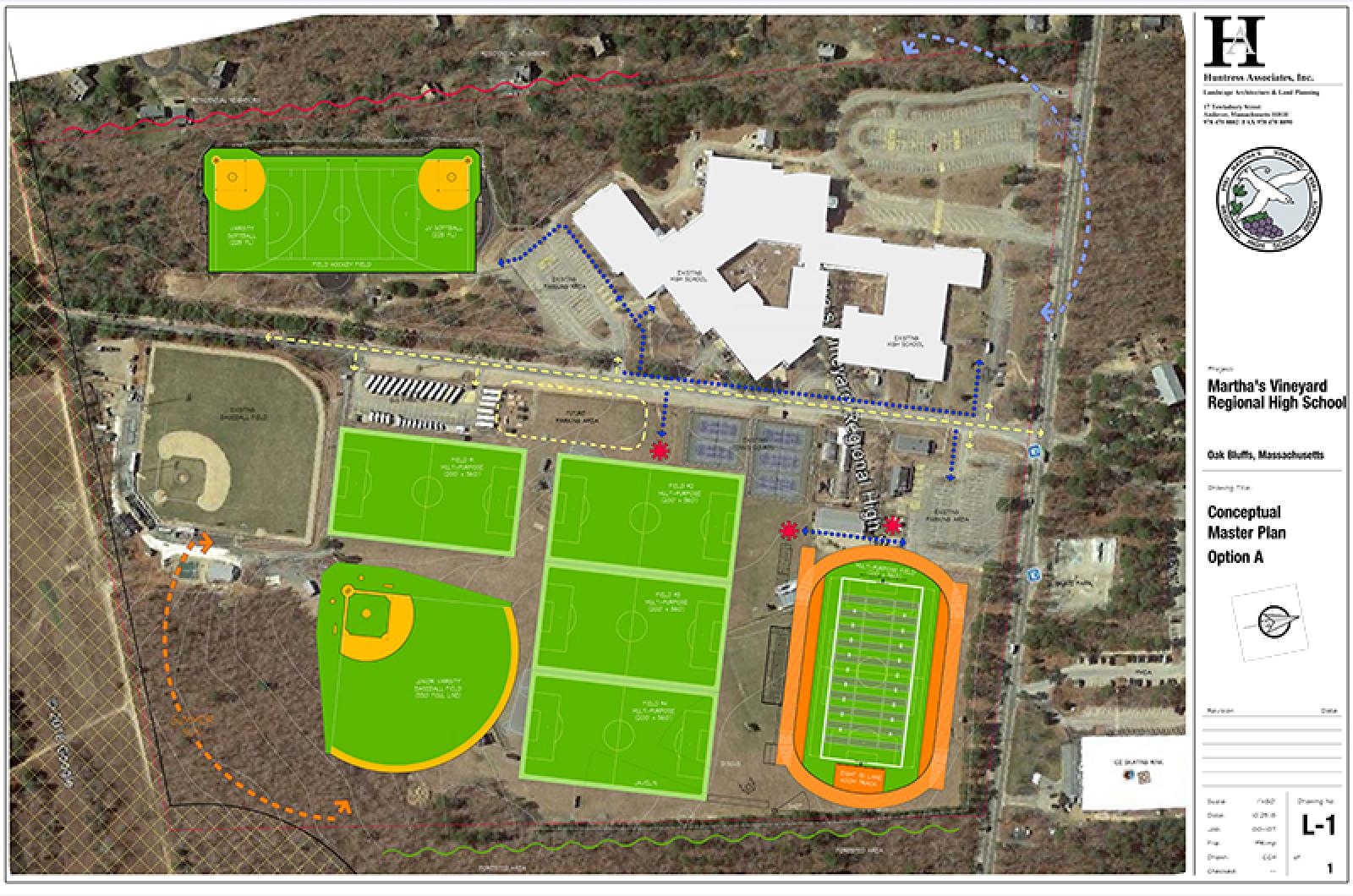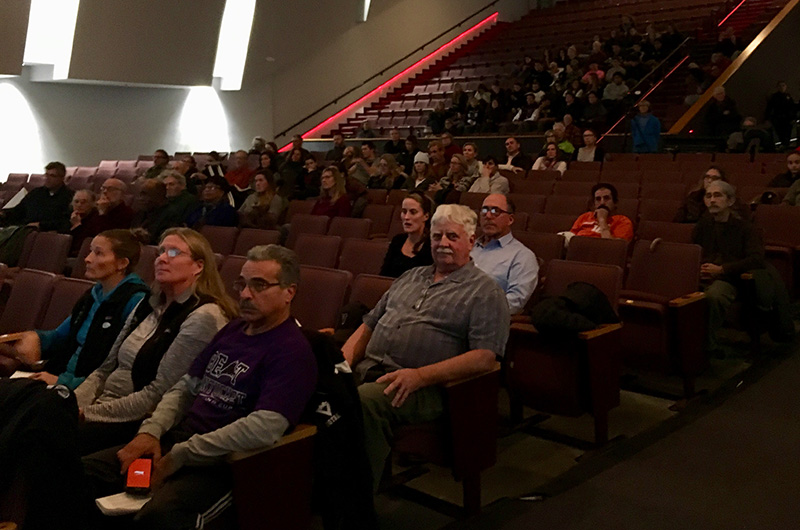The question of natural grass versus artificial turf dominated public comment at a meeting called last week to air ongoing plans to overhaul the athletic fields at the regional high school.

And while there remains disagreement on that point, coaches, parents, neighbors and athletes all agreed readily that the existing fields are in need of serious improvement.
“I’ve been coming to these fields since I was four years old to watch all of my siblings play and I haven’t seen improvement in, like ever,” said high school sophomore Becket Wadleigh. “I’m a goalkeeper. I dive on rocks. I end up in games where I’m bleeding out of my hips and knees,” she added.
The athletic fields have come under scrutiny after the school struggled to find a solution to renovate the track, which was resurfaced last October and will need to be replaced in two years.
The design phase of the project has now broadened to include all the sports fields, with the track as an urgent priority.
Designer Chris Huntress of Huntress Associates stayed neutral about surface material he presented a preliminary design for the layout of the fields at the meeting last Thursday night. Among other changes, Mr. Huntress proposed relocating the track to surround the football field and realigning the football field to run parallel with the Edgartown-Vineyard Haven Road. He also suggested relocating the two softball fields to the existing track site. The proposed realignments saw enthusiastic response.
Huntress expects to complete a master plan, including surface material recommendations, by Dec. 15.
Moderated by Oak Bluffs town moderator Jesse (Jack) Law 3rd, the meeting saw comment from athletes and coaches, including from outside the high school program.
“We need more places for our kids to play and space that allows our athletic organizations to grow,” said MV United soccer coach Matthew Mulowski.
Many who attended said they preferred turf fields, citing the changing nature of athletics, heavy use of the fields and poor conditions on the existing fields. Veteran football coach and physical education teacher Donald Herman was among the turf proponents.
“We have been on these fields as a [physical education] teacher or a coach for 30 years,” he said, with a nod to field hockey coach Lisa Knight and track and cross country coach Joe Schroeder. “We have seen the deterioration of these fields all these years. With all the youth sports and high school sports and teams that have been growing . . . it needs to be turf, that’s the only way it’s going to survive.”
Ms. Knight, who is retiring, later agreed, saying her team has been at a disadvantage.
“The game of field hockey is a turf sport now and will always be,” she said. She added, “We cannot compete for a league championship or advance in the MIAA tournament without a proper playing surface, and that proper playing surface is turf.”
Senior multi-sport athlete Meghan Sonia echoed the praise for turf.
“Anybody who plans to play at the collegiate level is being held back right now by the quality of these fields,” she said. “Collegiate level you do play on turf, that’s just how everything is evolving.”
Others were not so sure, citing environmental concerns.
“Can you just imagine those disposable fields being shipped off in a freight boat?” said Moira Silva. “We have to think about the life cycle of everything we get. Where did it come from? It came from a factory,” she said. “Let’s encourage our students to refuse the plastic field racket and invest in our soil instead.”
Chuck Hodgkinson of West Tisbury said athletes should not take the existing field conditions to mean that grass fields could never be successful.
“The fields are in their shape because we haven’t maintained them for you properly. That will change,” he said. “So please don’t evaluate grass versus turf on the current condition of the fields.”
In an overview, Mr. Huntress described the orientation and conditions of the existing fields based on six weeks of research and interviews with athletes and coaches.
The asphalt on the track is more than 20 years old and at the end of its lifespan, he said. And he did not mince words about the track’s grass infield.
“I would say it’s in poor condition,” he said of the grass. “The surface rolls. It has dips and valleys to a pretty extensive degree.”
The football field grass is in better condition, Mr. Huntress said, but sees significant wear throughout the season.
“During wetter conditions it gets quite challenged because of the amount of use that it gets,” he said.
Taking in the campus as a whole, Mr. Huntress said few of the fields or spectator areas were adequately accessible, and the location of the fields could be rearranged entirely.
“Although some aren’t bad, it’s inefficient and the orientation is not preferred,” he said. “There’s a lot of overlap in these fields.”
But he also said the site has good soil, is well-drained and offers plenty of space.
“I’ve got clients that would kill for that kind of a site, I’ve got to tell you,” he said.








Comments (4)
Comments
Comment policy »